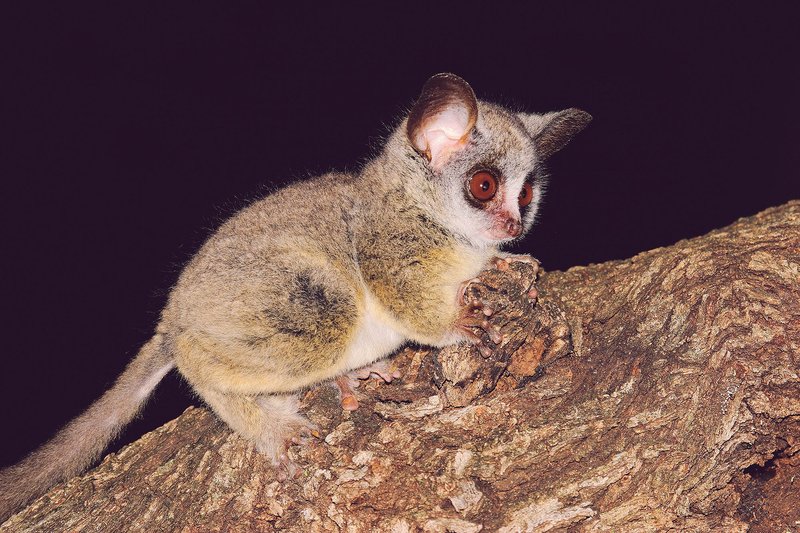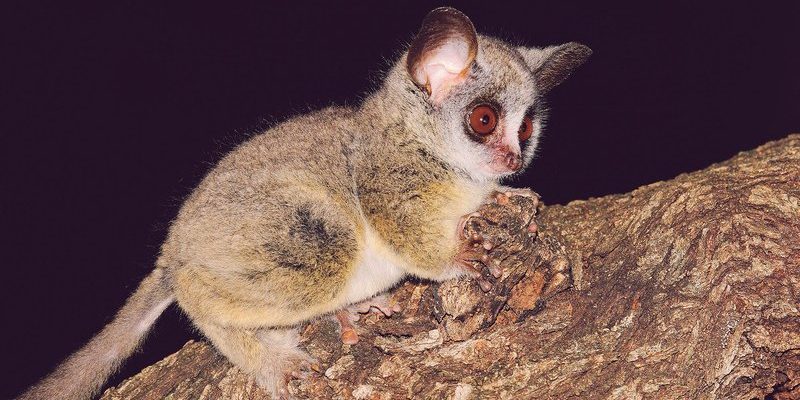
When you think of cute animals, does a tiny, wide-eyed creature come to mind? If not, let me introduce you to the bushbaby, also known as the galago. These small primates are known for their remarkable agility and charming appearance, making them one of nature’s delightful wonders. Imagine a creature that can leap from tree to tree with the grace of a gymnast, while also being incredibly vocal at night, filling the African forests with their unique calls. Isn’t that fascinating?
Bushbabies are not just adorable; they’re also unique in their adaptations and behaviors. Despite their small size, they play crucial roles in their ecosystem, helping with seed dispersal and insect control. You might be wondering where to find them or what they eat. Let’s dive in, as there’s a lot to explore about these intriguing little primates!
Physical Characteristics
Bushbabies are small, typically weighing between 1 to 2.5 pounds and measuring about 12 to 16 inches in length, including their long tails. Their large, round eyes are perfect for their nocturnal lifestyle, enabling them to see well in low light. Their fur can range from gray to brown, and they have distinctive markings on their faces, making them look almost like tiny little owls when viewed from the front.
One of their most astounding features is their incredible sense of hearing. Bushbabies have ears that can rotate, allowing them to pinpoint the faintest sounds in the dark. This acute hearing helps them detect predators and find food, such as insects, fruits, and tree gums. Their strong hind legs are built for jumping, propelling them up to 10 feet in a single bound, which is like you leaping over a small car! Isn’t that mind-blowing?
Moreover, the bushbaby’s tail is not just for show—it helps them balance as they sprint through the trees. Their powerful legs and gripping hands make them experts at navigating the complex canopy of their forest homes. To sum up, these little marvels combine agility, keen senses, and adorable looks into one impressive package.
Habitat and Distribution
Bushbabies are primarily found in the forests of Africa, from the savannahs to tropical rainforests. They prefer environments that offer plenty of trees for climbing and jumping, as well as foliage that provides cover from predators. These small primates thrive in both wooded areas and urban environments, showcasing their adaptability.
In terms of distribution, you can find bushbabies in countries like Kenya, Tanzania, and South Africa. Each species of bushbaby may inhabit different regions, with some being more common in specific areas than others. Their nocturnal nature means they’re rarely seen during the day, often making spotting one a rare treat for wildlife enthusiasts.
Interestingly, bushbabies are social animals, usually living in small family groups. These groups help each other find food and warn each other of danger. When they do come together, they create a symphony of sounds, communicating through calls that can be heard for miles. Imagine walking through the forest at night and hearing these little voices echoing through the trees—it’s an experience like no other!
Diet and Feeding Habits
Bushbabies are omnivores, which means they enjoy a variety of foods. Their diet mainly consists of fruits, leaves, flowers, and insects. They have a particular fondness for tree gums, which they extract using their sharp teeth and long tongues. It’s like having a gourmet dessert menu in the treetops!
To feed, bushbabies use their exceptional sense of smell and keen eyesight, allowing them to locate ripe fruits and tasty insects even in the dark. They are also known to forage alone or in pairs, taking advantage of their agility to leap between branches in search of food. While they are skilled foragers, they are also vigilant for predators, always keeping an eye out for danger.
Another interesting aspect of their diet is their role in the ecosystem. As they eat fruits and disperse seeds through their droppings, they help maintain the health and diversity of their habitat. Without creatures like bushbabies, many plants wouldn’t have the same chance to thrive. So, in a sense, they’re not just cute; they’re essential to the forest’s landscape!
Behavior and Social Structure
Bushbabies are incredibly social creatures, often living in family groups that maintain strong bonds. They communicate through a range of vocalizations, from soft coos to loud howls, which help them stay connected, especially in the dense forest where visibility is low. It’s fascinating how each call can convey different messages, whether it’s a warning of danger or a signal to rally the group.
During the day, they typically rest in tree hollows or dense foliage to avoid predators, coming alive at night. Their nocturnal lifestyle means they have developed strong adaptations for nighttime activity, such as excellent night vision and heightened senses. They tend to be playful, engaging in activities that look like a mix of gymnastics and tag as they chase each other between branches.
During mating season, bushbabies demonstrate elaborate courtship behaviors. Males will perform impressive jumps and vocal displays to attract females. This is not just for show; the stronger the display, the more likely a female will choose him as her mate. Their social structure is complex, often involving intricate interactions that can be quite entertaining to observe!
Conservation Status
Sadly, bushbabies face threats from habitat loss due to deforestation and urbanization. As their forest homes are cut down for agriculture and development, their populations decline. Bushbabies are listed as vulnerable in several areas, and conservation efforts are crucial to protect these charming creatures.
Many organizations are working to preserve their habitats and educate local communities about the importance of bushbabies in the ecosystem. Protecting these animals means ensuring that they can continue to play their vital role in seed dispersal and insect control.
Efforts also include creating protected areas where bushbabies can thrive away from human interference. By raising awareness of their plight, we can help ensure that future generations have the chance to see these fascinating creatures in the wild. Together, we can make a difference in the conservation of bushbabies and their habitats!
Fun Facts About Bushbabies
| Fact | Details |
|---|---|
| Size | Bushbabies weigh between 1-2.5 pounds and measure about 12-16 inches. |
| Habitat | Found in various African forests and urban environments. |
| Diet | Omnivorous, feeding on fruits, insects, and tree gums. |
| Jumping Ability | Can leap up to 10 feet in one jump! |
| Social Structure | Live in small family groups, communicating with various vocalizations. |
| Conservation Status | Listed as vulnerable due to habitat loss. |
FAQ
What is a bushbaby’s lifespan in the wild?
Bushbabies typically live for about 12 to 16 years in the wild. However, their lifespan can be influenced by factors such as predation, availability of food, and habitat conditions. In captivity, with proper care, some bushbabies can live longer, often reaching up to 20 years.
Are bushbabies social animals?
Yes, bushbabies are very social creatures. They usually live in small family groups and maintain strong bonds with each other. Communication among them is key, as they use a variety of vocalizations to express different messages, from alerts about predators to calls for companionship.
How do bushbabies find food?
Bushbabies rely on their excellent sense of smell and keen eyesight to locate food, especially at night. They are agile climbers, using their strong limbs to leap between trees and forage for fruits, leaves, and insects. Their nocturnal habits allow them to hunt during times when many of their predators are inactive.
Can bushbabies be kept as pets?
While bushbabies are adorable, they are wild animals and have specific needs that can be difficult to meet in captivity. They require a lot of space to climb and explore, a specialized diet, and social interaction. In many places, it’s also illegal to keep them as pets due to conservation laws.
What threats do bushbabies face?
Bushbabies face significant threats from habitat loss due to deforestation and urbanization. As their natural environments disappear, their populations decline. Other threats include hunting and poaching. Conservation efforts are crucial to protect their habitats and ensure their survival.
How do bushbabies communicate?
Bushbabies have a range of vocalizations to communicate with each other. They can produce different sounds to warn of danger, call for mates, or maintain contact within their group. Their vocal behavior is quite complex, showcasing their social nature.
Are bushbabies good jumpers?
Absolutely! Bushbabies are known for their incredible jumping abilities. They can leap up to 10 feet in a single bound, thanks to their powerful hind legs. This agility helps them navigate through their arboreal habitat effectively and avoid predators.
Do bushbabies hibernate?
No, bushbabies do not hibernate. Instead, they remain active year-round, primarily nocturnal in nature. They sleep during the day in tree hollows or dense foliage, emerging at night to feed and socialize. Their adaptability to different environments helps them thrive without the need for hibernation.
Are all bushbabies the same species?
No, there are several species of bushbabies, each adapted to different habitats across Africa. They vary slightly in size, appearance, and social behaviors. Some of the more well-known species include the common bushbaby, the thick-tailed bushbaby, and the lesser bushbaby.
What is the bushbaby’s scientific name?
The bushbaby belongs to the family Galagidae, and its scientific name can vary among species. For instance, the common bushbaby is known as Galago senegalensis. The name “bushbaby” refers to several species within this family, all sharing similar characteristics.
How do bushbabies affect their ecosystem?
Bushbabies play a vital role in their ecosystem by helping with seed dispersal. As they eat fruits and leave behind seeds, they assist in the growth of new plants and trees. Additionally, they help control insect populations, contributing to the balance of their habitat.
Can bushbabies see in the dark?
Yes, bushbabies have large eyes that are well adapted for night vision. Their eyes can capture more light, allowing them to see in low-light conditions, which is vital for their nocturnal lifestyle. This adaptation helps them navigate their environment and find food while avoiding predators.

